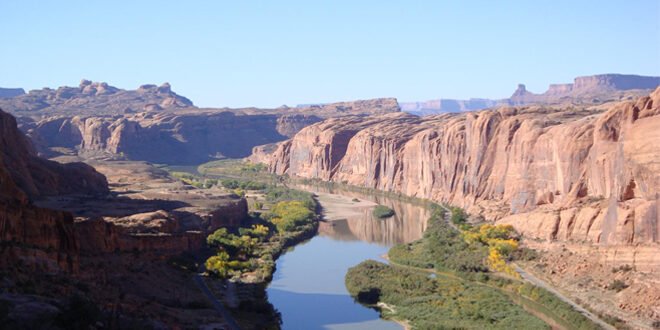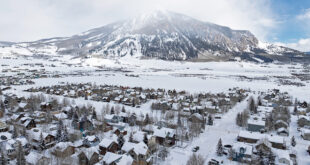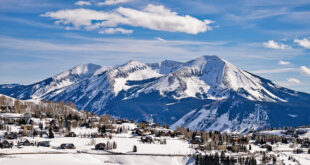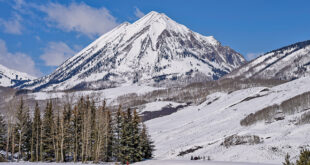The deck at the office has more than five feet of compressed snow on it so it might be a while before we can sit outside and do some work out there. But it might not be all that long since some temperatures during this early April week hit the high 50s. It is all indicative of why the high-profile fight over water in the Colorado River is getting a bit of a reprieve, but action needs to be taken quickly.
The Universe provided this winter’s big snowfall which will help refill the river more than anticipated. This season’s snowfall offers the seven Colorado River Compact states (Colorado, Wyoming, Utah, New Mexico, Arizona, Nevada, California) extra time to figure out how best to compromise, divvy up and manage this shrinking resource. That reprieve, combined with this week’s analysis by the Biden administration’s Interior Department suggesting it may implement one of three alternative river solutions if the states can’t figure it out themselves, should wake up the seven states to come up with their own best solution. Good snow in 2023 does not mean it is a good idea to kick the can down the road.
Crested Butte basically sits at one of the headwaters of the Colorado River. Some of that 5 feet of snow on the deck will melt and find its way to Utah, Nevada or California. Despite this year’s copious snowfall, the greater region that supplies and uses the water in the Colorado River has been in a 23-year drought. And like the slow-motion train wreck that is climate change, people have chosen to take some mitigation measures while continuing to overuse what is in the river. By the time the river gets to Mexico, it is pretty much a drip compared to what it was decades ago.
Between 85% and 90% of the Colorado River’s discharge originates from melting snowpack in the mountains of Colorado and Wyoming. The Gunnison Basin is a major player in the water supply. The Colorado River supplies drinking water to more than 40 million Americans and two states in Mexico. It helps to irrigate 5.5 million agricultural acres.
River flows of late have fallen by more than 20%, and the water levels in Lake Mead and Lake Powell are so depleted that there soon might not be enough water to turn the electric turbines that generate power for many homes and businesses in the West. The shi* has hit the fan and, despite the reprieve with good snow from this ski season, the long-term future of the water continues to look wobbly.
So, the feds on Tuesday fired the clear warning shot that if the states cannot find a way to share the water, it will. And it likely won’t be pretty. While six of the seven states reached a potential compromise earlier this year, California wouldn’t play ball because it holds the most senior water rights. The feds say that’s great, but it won’t stand up when they basically say California, Nevada and Arizona will have to take equal reductions of water no matter the senior water rights. That could hurt the agriculture industry in California that helps feed all of us and no doubt would have lawyers lining up to file lawsuits.
The combination of climate change taking away water from one of the life-giving veins of the American West with more people moving to a sunny spot with space or demanding more agricultural products from Southern California is a problem. The original river agreement was made in 1922 when there were a lot fewer people on the land and a lot more water in the river. Today’s reality is different, and if the seven states don’t come to a new agreement that reflects that new reality, the federal government will do it for them. And that would provide an uncertain future for all communities that use the river. Who knows what the ultimate impacts would be up here at the headwaters. If nothing else, I could see a few thirsty refugees migrating to the source of water in the future. Just what we need!
This winter’s sweet snowpack gives everyone a bit more breathing room but that could change at any time. Taylor Reservoir is expected to fill up this year but what about next year and the year after? The major cities that rely on the Colorado River have actually done some pretty good things to conserve and reuse water, but it’s not enough. Now is the time to face the facts and face the pain. Along with a reworked agreement, it would also be the right time to address issues with Native American tribes, the agreement with Mexico and the need for water for birds and other wildlife. It is time to be innovative, creative…and real.
That 5 feet of snow on the deck during a 55-degree Tuesday afternoon is showing we have a bit of a buffer to figure stuff out. The feds on Tuesday said now is the time for the states in the agreement to do it themselves…or else. It would be a shame to not act while we can see the buffer the Universe has provided — because we will also witness how fast that buffer goes away as record temperatures are recorded for April….
—Mark Reaman
 The Crested Butte News Serving the Gunnison Valley since 1999
The Crested Butte News Serving the Gunnison Valley since 1999





